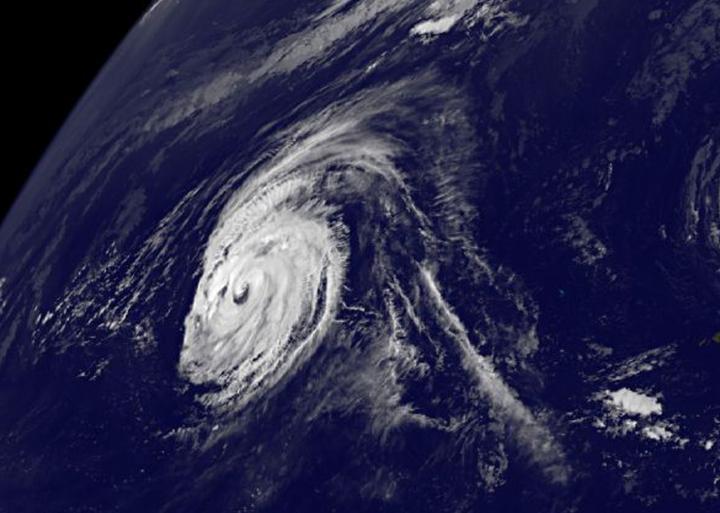Typhoon Kilo moving through northwestern Pacific Ocean

At 11 a.m. EDT on Sept. 2, Typhoon Kilo's eye was visible in a GOES-West satellite image. Credits: NASA/NOAA GOES Project
At 11 a.m. EDT on September 2, Typhoon Kilo's maximum sustained winds were near 90 knots (103.6 mph/166.7 kph).
It was centered near 24.3 North and 179.1 East, about 762 nautical miles east-northeast of Wake Island. Kilo was moving very slowly at 3 knots (3.4 mph/5.5 kph).
At that time, Typhoon Kilo's eye was visible in a satellite image from NOAA's GOES-West satellite. The image also showed powerful bands of thunderstorms wrapping into the low level center of circulation.
GOES-West is managed by NOAA. The image was created by NASA/NOAA's GOES Project at NASA's Goddard Space Flight Center in Greenbelt, Maryland.
Fortunately, Kilo is in open waters and is currently no threat to land areas.
The Joint Typhoon Warning Center expects Kilo to re-strengthen and continue tracking west. It is expected to peak in intensity on September 6.
Media Contact
All latest news from the category: Earth Sciences
Earth Sciences (also referred to as Geosciences), which deals with basic issues surrounding our planet, plays a vital role in the area of energy and raw materials supply.
Earth Sciences comprises subjects such as geology, geography, geological informatics, paleontology, mineralogy, petrography, crystallography, geophysics, geodesy, glaciology, cartography, photogrammetry, meteorology and seismology, early-warning systems, earthquake research and polar research.
Newest articles

First-of-its-kind study uses remote sensing to monitor plastic debris in rivers and lakes
Remote sensing creates a cost-effective solution to monitoring plastic pollution. A first-of-its-kind study from researchers at the University of Minnesota Twin Cities shows how remote sensing can help monitor and…

Laser-based artificial neuron mimics nerve cell functions at lightning speed
With a processing speed a billion times faster than nature, chip-based laser neuron could help advance AI tasks such as pattern recognition and sequence prediction. Researchers have developed a laser-based…

Optimising the processing of plastic waste
Just one look in the yellow bin reveals a colourful jumble of different types of plastic. However, the purer and more uniform plastic waste is, the easier it is to…



